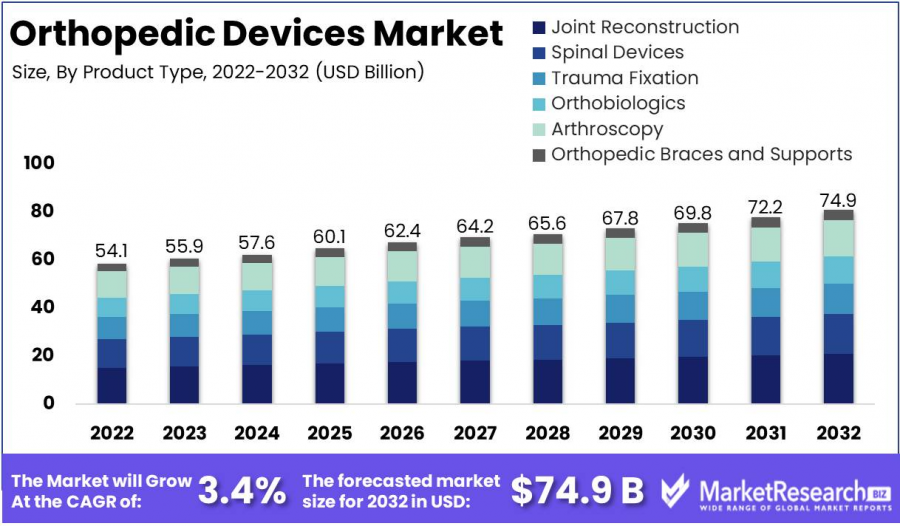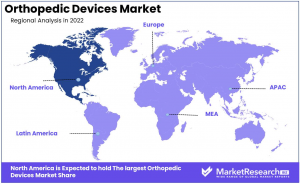
Orthopedic Devices Market Expected To Exceed USD 74.9 Billion By 2032 | Medtronic PLC, DJO Global Inc., NuVasive Inc.
Global Orthopedic Devices Market size is expected to be worth around USD 74.9 Bn by 2032 from USD 55.9 Bn in 2023, growing at a CAGR of 3.4%
NEW YORK , NY, UNITED STATES, January 28, 2025 /EINPresswire.com/ -- Report Overview
Global Orthopedic Devices Market size is expected to be worth around USD 74.9 Bn by 2032 from USD 55.9 Bn in 2023, growing at a CAGR of 3.4% during the forecast period from 2023 to 2032.
Orthopedic devices are specialized medical tools designed to support, stabilize, or replace bones, joints, and soft tissues. These devices are crucial for the treatment of musculoskeletal conditions, injuries, and disorders, helping patients regain mobility, alleviate pain, and improve their quality of life.
Modern orthopedic devices are used across various applications, including joint reconstruction, spinal surgeries, trauma management, and sports medicine. Common examples include prosthetic implants, fracture fixation devices, and arthroscopic tools. With advancements in materials such as titanium alloys and biocompatible polymers, these devices offer enhanced durability, reduced risk of rejection, and faster recovery times for patients.
The orthopedic devices market is witnessing rapid growth, driven by increasing incidences of arthritis, osteoporosis, and sports injuries. According to healthcare reports, over 1.5 million hip and knee replacement surgeries are performed annually worldwide, highlighting the growing demand for joint reconstruction devices. Additionally, the rise in the aging population further accelerates the need for innovative orthopedic solutions.
Technological advancements, including robotic-assisted surgeries, 3D printing, and smart implants, are transforming the orthopedic field. These innovations allow for customized devices, precise surgical procedures, and real-time monitoring, leading to better patient outcomes and reduced healthcare costs.
Global leaders in the orthopedic devices industry continue to invest in R&D, ensuring the development of cutting-edge products that meet diverse patient needs. Emerging markets are also experiencing growth due to increased healthcare access and awareness.
Unlock Competitive Advantages With Our PDF Sample Report @ https://marketresearch.biz/report/orthopedic-devices-market/request-sample/
Key Takeaways
Market Size: Orthopedic Devices Market size is expected to be worth around USD 74.9 Bn by 2032 from USD 55.9 Bn in 2023.
Market Growth: The market growing at a CAGR of 3.4% during the forecast period from 2023 to 2032.
Key Takeaways: Orthopedic Devices Market
Technological Advancements: Robotic-assisted surgeries, 3D printing, and smart implants are transforming orthopedic care with greater precision and patient-specific solutions.
Aging Population: Rising elderly demographics worldwide fuel demand for joint reconstruction and fracture fixation devices.
High-Impact Applications: Joint reconstruction devices dominate the market due to the growing number of hip and knee replacement procedures, exceeding 1.5 million annually.
Emerging Markets: Growth in emerging regions is bolstered by increased healthcare access, awareness, and adoption of advanced orthopedic technologies.
Global Leaders: Companies are heavily investing in R&D to develop innovative, biocompatible materials and durable devices for better patient outcomes.
How Artificial Intelligence (AI) is Transforming the Orthopedic Devices Market ?
1. Robotic-Assisted Surgeries: AI powers robotic systems for orthopedic procedures such as joint replacements, allowing for higher precision and minimally invasive techniques. This results in reduced recovery time and improved patient outcomes.
2. Predictive Analytics: AI analyzes patient data to predict surgical outcomes, assess risk factors, and personalize treatment plans. This enables surgeons to make informed decisions and improve success rates.
3. Smart Implants: AI-integrated orthopedic implants monitor patient recovery by collecting real-time data on joint movement, stress, and healing progress. These insights allow healthcare providers to track recovery and make timely adjustments.
4. 3D Printing and Design Optimization: AI assists in designing patient-specific implants and orthopedic devices using 3D printing. This customization ensures better fit and performance, enhancing comfort and functionality.
5. Rehabilitation and Monitoring: AI-enabled wearables and apps guide patients through post-surgery rehabilitation, providing personalized exercises and tracking progress. This technology promotes faster recovery and better compliance.
6. Supply Chain Optimization: AI optimizes production and distribution processes, ensuring timely delivery of orthopedic devices while minimizing costs and waste.
Market Segments
Product Type
• Joint Reconstruction
• Spinal Devices
• Trauma Fixation
• Orthobiologics
• Arthroscopy
• Orthopedic Braces and Supports
Material
• Metallic Implants
• Polymeric Materials
• Ceramic Materials
Applications
• Spine
• Hip
• Knee
• Craniomaxillofacial
• Dental
• Sports Injuries, Extremities, and Trauma (SET)
End-User
• Orthopedic Clinics
• Hospitals
• Ambulatory Surgical Centers
• Others(Rehabilitation Centers, Sports Medicine Centers, And Home Healthcare)
Buy This Premium Research Report - https://marketresearch.biz/purchase-report/?report_id=5723
Market Dynamics
Driver: Aging Population and Rising Musculoskeletal Disorders
The increasing global elderly population leads to a higher prevalence of musculoskeletal disorders, such as osteoarthritis and osteoporosis, thereby driving the demand for orthopedic devices. According to the World Health Organization (WHO), musculoskeletal conditions are the leading contributor to disability worldwide, with approximately 1.71 billion people affected. The aging demographic is more susceptible to such conditions, necessitating surgical interventions and the use of orthopedic implants to restore mobility and improve quality of life.
Trend: Technological Advancements in Orthopedic Surgery
Advancements in medical technology, including minimally invasive surgical techniques and the development of biocompatible materials, are significant trends in the orthopedic devices market. The National Institutes of Health (NIH) highlights the emergence of 3D-printed implants and patient-specific instruments, which enhance surgical precision and patient outcomes. These innovations reduce recovery times and improve the longevity of implants, making them increasingly popular in orthopedic procedures.
Restraint: High Costs of Orthopedic Procedures
The high cost associated with orthopedic surgeries and devices poses a restraint to market growth. A study published in the National Center for Biotechnology Information (NCBI) analyzed the direct costs of single-level lumbar fusions, revealing a significant range from $8,286 to $73,727 per procedure. These substantial expenses can limit accessibility for patients, particularly in regions lacking comprehensive healthcare coverage, thereby hindering the widespread adoption of advanced orthopedic solutions.
Opportunity: Growth in Medical Tourism
The rise of medical tourism presents a notable opportunity for the orthopedic devices market. Patients from countries with high medical costs are seeking affordable and high-quality orthopedic treatments abroad. The Asia-Pacific region, including countries like Thailand, South Korea, and India, has become a major player in the global medical tourism industry, offering advanced orthopedic procedures at competitive prices. This trend is expected to boost the demand for orthopedic devices in these emerging markets.
Regional Analysis
Orthopedic devices are vital for supporting and treating musculoskeletal disorders and injuries. The North American orthopedic device market has grown significantly, driven by increasing incidences of musculoskeletal disorders, an aging population, and advancements in technology. The U.S. dominates the regional market due to its high adoption of advanced devices, favorable reimbursement policies, and the presence of leading industry players. The aging population further boosts demand for orthopedic solutions.
Technological advancements, including genetic engineering, robotics, and artificial intelligence, are key drivers, enabling the development of better materials, more efficient surgical procedures, and improved patient outcomes. Innovations like 3D printing and advanced prosthetics have streamlined manufacturing and enhanced device efficacy.
Despite growth opportunities, challenges such as high device costs, stringent government regulations, and post-surgical complications remain barriers to market expansion. Collaborative efforts among medical professionals, researchers, and developers aim to improve orthopedic devices and create innovative treatments for musculoskeletal disorders.
Competitive Landscape
Stryker Corporation is a leading player in the orthopedic devices market, offering a diverse portfolio of products in joint reconstruction, trauma, and sports medicine. The company’s strong focus on research and development drives the introduction of innovative technologies, enhancing its competitive edge.
Zimmer Biomet Holdings Inc. specializes in joint reconstruction, spine, and dental implants. Renowned for its advanced implant technologies, Zimmer Biomet is a key innovator in joint replacement solutions.
Johnson & Johnson, through its subsidiary DePuy Synthes, holds a significant market presence. The company provides a wide range of products for joint replacement, trauma, sports medicine, and spine surgery, leveraging its global healthcare expertise.
Smith & Nephew plc emphasizes innovation to improve patient outcomes, focusing on joint reconstruction, sports medicine, and wound care. Its commitment to technological advancement strengthens its position in the market. Medtronic PLC specializes in spine surgery and neurostimulation devices. The company is recognized for its robust R&D initiatives in medical technology, driving advancements in orthopedic care.
Top Key Players
• NuVasive Inc.
• Johnson & Johnson
• Smith & Nephew Plc
• Medtronic PLC
• DJO Global Inc.
• Zimmer-Biomet Holdings
• DePuy Synthes Companies
• Stryker Corporation
• Aesculap Implant Systems Inc.
• Donjoy Inc.
• Conmed Corporation
• Globus Medical
Emerging Trends in Orthopedic Devices
1. 3D Printing for Customization: Three-dimensional (3D) printing is revolutionizing orthopedic surgery by enabling the creation of patient-specific implants and surgical guides. This customization enhances the fit and function of implants, leading to better surgical outcomes and reduced recovery times.
2. Robotic-Assisted Surgery: The integration of robotics in orthopedic procedures, particularly joint replacements, allows for greater precision in implant positioning and alignment. This technology aids surgeons in performing complex tasks with improved accuracy, potentially reducing surgical errors and enhancing patient recovery.
3. Smart Implants and Wearable Technology: The development of smart implants equipped with sensors enables real-time monitoring of parameters such as load and strain on orthopedic devices. Wearable technologies also assist in tracking patient rehabilitation progress, providing data that can be used to tailor personalized treatment plans.
4. Digitalization and Telemedicine: The adoption of digital tools, including telemedicine platforms and remote monitoring, has expanded access to orthopedic care. Patients can now receive consultations and follow-up care virtually, increasing convenience and potentially improving adherence to treatment protocols.
Use Cases of Orthopedic Devices
1. Joint Replacement Surgeries: Devices such as artificial hip and knee joints are commonly used to replace damaged joints due to arthritis or injury. In the United States, over a million hip and knee replacement surgeries are performed annually, helping patients regain mobility and reduce pain.
2. Spinal Fusion Procedures: Orthopedic implants like rods, screws, and cages are utilized in spinal fusion surgeries to stabilize the spine and alleviate chronic back pain caused by conditions such as degenerative disc disease.
3. Fracture Fixation: Plates, screws, and intramedullary nails are employed to hold broken bones in proper alignment during the healing process. These devices are essential in treating fractures resulting from trauma or osteoporosis.
4. Sports Medicine Applications: Orthopedic devices, including arthroscopic tools and ligament repair implants, are used in minimally invasive procedures to address sports-related injuries like torn ligaments and tendons, facilitating quicker recovery and return to activity.
Lawrence John
Prudour
+91 91308 55334
Lawrence@prudour.com
Distribution channels: Healthcare & Pharmaceuticals Industry
Legal Disclaimer:
EIN Presswire provides this news content "as is" without warranty of any kind. We do not accept any responsibility or liability for the accuracy, content, images, videos, licenses, completeness, legality, or reliability of the information contained in this article. If you have any complaints or copyright issues related to this article, kindly contact the author above.
Submit your press release


